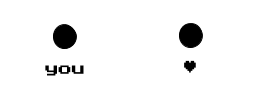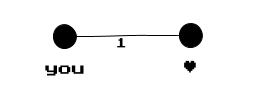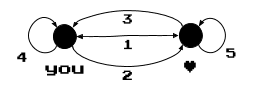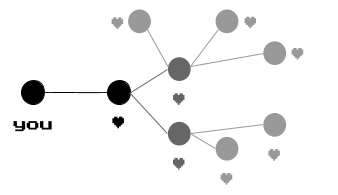
amcasari 🦕
Posted on March 25, 2020
(Part 1 of the series: Introducing Mathematical Concepts for Confronting a Crisis))
One of the skills you must master as a lifelong professional generalist is how to translate what people around you are saying versus what they mean.
In technology fields, there are terms that we do have consensus on. These can be used in meetings where people of all backgrounds and levels are present without further definition: words like “the”, “and”, “before”, “after”. Other terms, it serves well for us all to define at least once so that we ensure we are all on the same page.
So, let’s kick off this series with the most basic concept of complex networks and network analysis: What is a network?
A network is another mathematical term for a graph, which is how we describe things and the relationships between them. The discrete object in the graph we are trying to describe can be called nodes, vertices, and points. These all mean the same thing. The relationship between these objects can be called edges, links, or lines. These also all mean the same thing. For this series, we will be referring to networks as containing nodes and edges. The size of your network is commonly defined as the number of nodes, or N.
What does this look like in abstract action? Well, think about the network that exists between you and...really, anyone else. Let’s go with someone that you care about and are invested in emotionally.
What is N here? It’s two, because there are two nodes in the network (you plus someone else)
Excellent! Now, what about how we can describe the different degrees of connection? This is where, excitingly, networks start to pick up and become more interesting. We’ll start with a simple connection, the idea that there is any relationship between you and someone else.
We could just stop there. This might be simple enough. The nodes in a network, plus a single edge connecting them. This represents that there are two objects and a relationship that can potentially be described in some way: ephemerally, musically, or preferably mathematically. We call this an undirected, unweighted graph, because there is no concept of directionality in the relationship or any kind of scale for the context that relationship represents.
What if we wanted this direction? We would need a directed graph, one that shows how the relationship is represented from the point of view of the node for an observer. We could then describe the relationship of “us” between two people.
Again, we can stop here, if this is most useful. However, now that we are describing human dynamics and relationships, the energy and space they take up, we could bump up our network to represent the full relationship which looks more like a “you, me, us” network.
Now we can fully represent the following people: you, the other person. This means that we have N = 2, with two nodes. We can also represent that there are in fact five different kinds of relationships at play between you, or five edges: (1) the “we” relationship, (2) your relationship with them, (3) their relationship with you, (4) your relationship with yourself, (5) their relationship with themself.
This is just for ONE relationship in your life! If we were to start extending this to ALL your relationships where you expend energy or are asked for energy from others, you can start to see how and where all your energy flows at any given time. If we were to add any kind of evaluation of how much energy is expended in a relationship, you would see that different edges carry different “weight”. This quantification of the relationship in some mathematical way is what gives us a weighted network. (This also explains why some relationships give you energy, some take more, and sometimes you just need “a break”.)
...okay. Now, you can see how networks are important to describe groups of people. Why is this most important now, in times of pandemic response?
Because...your N matters more now than ever. Specifically, the N that describes your contact with other people in less than a 6-foot radius, which is currently the distance that science is recommending we keep from other people as much as possible.
You need to understand what your N truly is, not what you think it is, most importantly that this could be changing over time.
If you truly self isolate, with no contact from other human beings, you can define yourself as N = 1, for that period of time. If you never sign for a delivery, if you don’t accept takeout from a delivery person within a six foot radius, if you don’t accidentally bump into someone when turning a corner, if you can continue to have everything delivered, you are able to maintain an N = 1.
Now, you might not have an option of N = 1. You might share living space with someone else.
“Yes”, you may say, “but I don’t do need to worry about that. I’m home with:
- my roommates
- ....and we only hang out with our significant others.
- my family
- ....and we only let the kids play next door with our neighbors.”
Start adding up all those “only” moments. Also, add in factors for:
- Does anyone in your network have a job they cannot work from home for?
- Does anyone need regular treatment that cannot be provided via telehealth that you know about?
- Does anyone have medicine that they alone must pick up from the pharmacy?
- Does anyone provide emergency care for a friend or neighbor when their loved ones get sick?
- Does anyone have to go out to get groceries/supplies/gas/formula/diapers/beer?
THESE ALL COUNT. Your interactions with other people define your N. Their interactions with other people, also define your N. (This is also how many social graphs quickly begin to look like hairballs.)
These connections may not all be sustained. They may never be relevant. There are many, many factors affecting your current N, and your ability to control what the minimum size of the network is that you can maintain. However, given the transmission nature of the current pandemic, knowing your network size and your risk of exposure for the past 14 days is very important.
My goal here is not to shame anyone. It is to make you more conscious about the choices that you do have, the choices that others do not, and how those two can have negative consequences on each other. It is to give you the tools to make a more informed, effective analysis of the environment that you are choosing to create for yourself and the environment that you are creating for others.
This is just step one: seeing your network, defining your interaction system, shifting your mind from focusing on one to many points in the system. This is crucial. We must shift our understanding of the systemic implications of simple actions to see the other side of the inflection point.

Posted on March 25, 2020
Join Our Newsletter. No Spam, Only the good stuff.
Sign up to receive the latest update from our blog.




